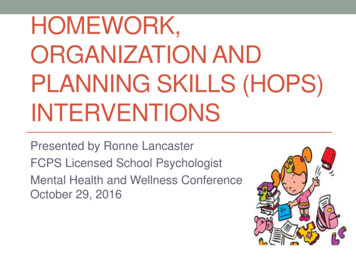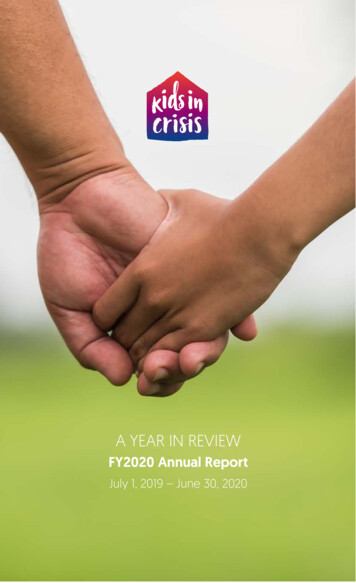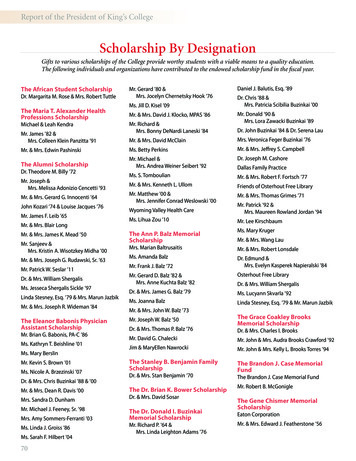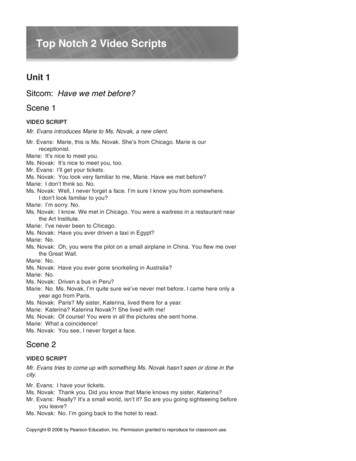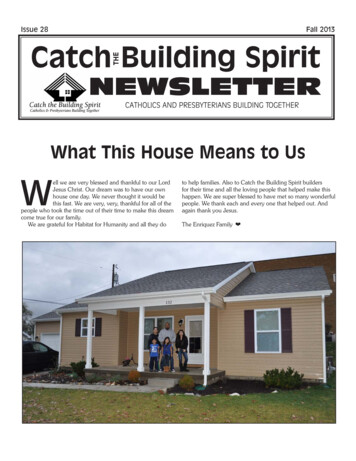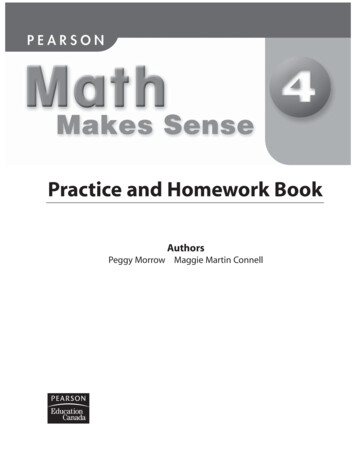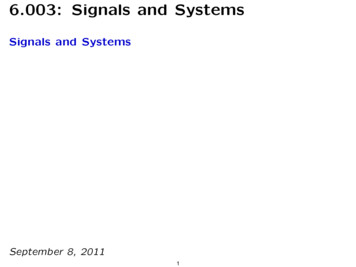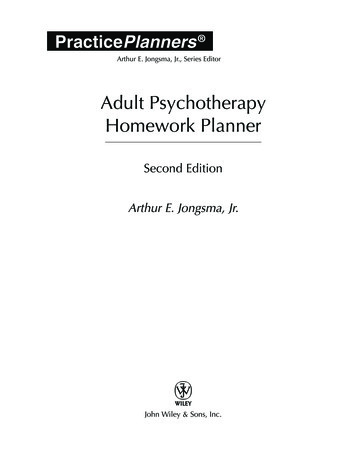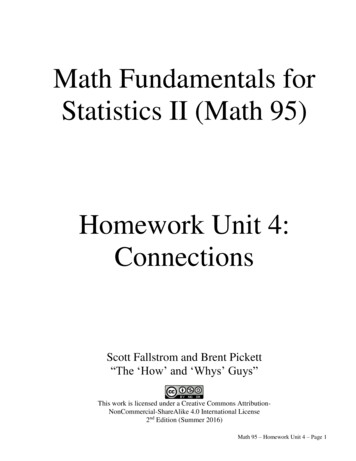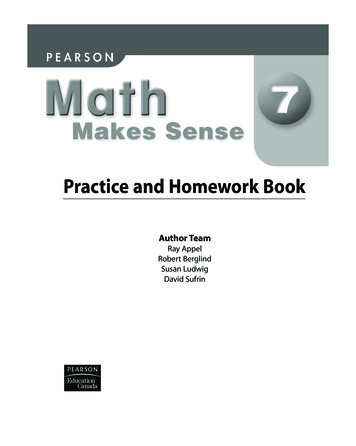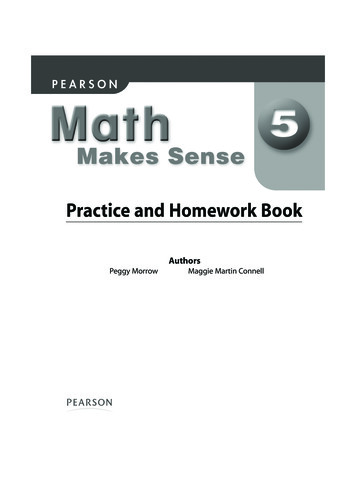
Transcription
Frontmatter SE.qxd6/26/083:42 PMPage iPractice and Homework BookAuthorsPeggy MorrowMaggie Martin Connell
Frontmatter SE.qxd6/26/083:42 PMPage iiPublisherMike CzukarResearch and Communications ManagerBarbara VogtPublishing TeamEnid HaleyClaire BurnettLesley HaynesAlison RiegerMei Lin CheungRuth PeckoverLynne GulliverStephanie CoxJane SchellKaren AlleyJudy WilsonDesignWord & Image Design Studio Inc.TypesettingComputer Composition of Canada Inc.Copyright 2009 Pearson Education Canada,a division of Pearson Canada Inc. All Rights Reserved.This publication is protected by copyright, andpermission should be obtained from the publisherprior to any prohibited reproduction, storage ina retrieval system, or transmission in any form orby any means, electronic, mechanical, photocopying,recording, or likewise. For information regardingpermission, write to the Permissions Department.ISBN-13: 978-0-321-46924-3ISBN-10:0-321-46924-0Printed and bound in Canada.2 3 4 5 -- WC -- 12 11 10 09 08
Frontmatter SE.qxd6/26/083:42 PMPage iiiContentsUNIT1Patterns and Equations . . . . . . . . . . . . . . . . . . . . . . . . . . . . .Lesson 1Lesson 2Lesson 3Lesson 5Lesson 6Lesson 7UNIT2UNIT3Number Patterns and Pattern RulesUsing Patterns to Solve ProblemsUsing a Variable to Describe a PatternUsing a Variable to Write an EquationSolving Equations Involving Additionand SubtractionSolving Equations Involving Multiplicationand Division24681012Whole Numbers . . . . . . . . . . . . . . . . . . . . . . . . . . . . . . . . . . . .Lesson 1Lesson 2Lesson 3Lesson 4Lesson 5Lesson 6Lesson 7Numbers to 100 000Exploring One MillionRepresenting NumbersEstimating SumsUsing Benchmarks to EstimateEstimating DifferencesUsing Estimation to Check Answers14161820222426Multiplying and Dividing Whole Numbers . . . . . . . . . . .Lesson 1Lesson 2Lesson 3Lesson 4Lesson 5Lesson 6Lesson 7Lesson 8Lesson 9Lesson 10Patterns in Multiplication and DivisionOther Strategies for Multiplying and DividingMultiplying with Multiples of 10Estimating Products to Solve ProblemsUsing Mental Math to MultiplyMultiplying 2-Digit NumbersEstimating Quotients to Solve ProblemsDividing a 3-Digit Number by a 1-Digit NumberOther Strategies for Dividing Whole NumbersSolving Problems28303234363840424446iii
Frontmatter SE.qxdUNIT46/26/083:42 PMMeasurement . . . . . . . . . . . . . . . . . . . . . . . . . . . . . . . . . . . . . .Lesson 1Lesson 3Lesson 4Lesson 5Lesson 6Lesson 7Lesson 8Lesson 9Lesson 10Lesson 11UNIT5UNIT6ivPage ivMeasuring LengthExploring Rectangles with Equal PerimetersExploring Rectangles with Equal AreasExploring VolumeMeasuring Volume in Cubic CentimetresConstructing Rectangular Prisms with aGiven VolumeMeasuring Volume in Cubic MetresExploring Capacity: The LitreExploring Capacity: The MillilitreRelating Capacity and Volume48505254565860626466Fractions and Decimals . . . . . . . . . . . . . . . . . . . . . . . . . . . . .Lesson 1Lesson 2Lesson 4Lesson 5Lesson 6Lesson 7Lesson 8Lesson 9Lesson 10Lesson 11Lesson 12Lesson 13Equivalent FractionsComparing and Ordering FractionsRelating Fractions to DecimalsFraction and Decimal BenchmarksExploring ThousandthsComparing and Ordering DecimalsUsing Decimals to Relate Units of MeasureRelating Fractions and Decimals to DivisionEstimating Sums and DifferencesAdding DecimalsSubtracting DecimalsAdding and Subtracting Decimals687072747678808284868890Geometry . . . . . . . . . . . . . . . . . . . . . . . . . . . . . . . . . . . . . . . . . .Lesson 1Lesson 2Lesson 3Lesson 4Lesson 6Lesson 7Describing ShapesInvestigating Perpendicular SidesInvestigating QuadrilateralsOther Attributes of QuadrilateralsExploring Faces and Edges of ObjectsDrawing Objects92949698100102
Frontmatter SE.qxd6/26/08UNIT7UNIT83:42 PMPage vStatistics and Probability . . . . . . . . . . . . . . . . . . . . . . . . . . .Lesson 1Lesson 2Lesson 3Lesson 4Lesson 5Lesson 6Lesson 7First-Hand Data and Second-Hand DataInterpreting Double Bar GraphsConstructing Double Bar GraphsThe Language of ProbabilityUsing Spinners to Compare LikelihoodsConducting ExperimentsDesigning Experiments104106108110112114116Transformations. . . . . . . . . . . . . . . . . . . . . . . . . . . . . . . . . . . .Lesson 1Lesson 3Lesson 4Lesson 5TranslationsReflectionsRotationsExploring Different Points of RotationMath at Home118120122124127v
Frontmatter SE.qxd6/26/083:42 PMPage viTo the TeacherThis Practice and Homework Book provides reinforcement of the concepts and skillsexplored in the Pearson Math Makes Sense 5 program.There are two sections in the book. The first section follows the sequence of Math MakesSense 5 Student Book. It is intended for use throughout the year as you teach the program.A two-page spread supports the content of each core lesson in the Student Book.In each Lesson:Quick Review summarizesthe math concepts andterminology of theStudent Book lesson.Try These presentsquestions the studentcan use to check understanding of the mathconcepts and skills ineach lesson.The right page is the“homework” page, to becompleted by the studentwith the assistance of afamily member.Stretch Your Thinkingpresents an extensionquestion.Math at HomeThe second section of the book, on pages 127 to 138, consists of 3 pull-out Math at Homemagazines. These fun pages contain intriguing activities, puzzles, rhymes, and games toencourage home involvement. The perforated design lets you remove, fold, and send homethis eight-page magazine after the student has completed Units 3, 6, and 8.vi
Frontmatter SE.qxd6/26/083:42 PMPage viiTo the FamilyThis book will help your child practise the math concepts and skills thathave been explored in the classroom. As you assist your child to completeeach page, you have an opportunity to become involved in your child’smathematical learning.The left page of each lesson contains a summary of the main concepts andterminology of the lesson. Use this page with your child to review thework done in class. The right page contains practice.Here are some ways you can help: With your child, read over the Quick Review. Encourage your child totalk about the content and explain it to you in his or her own words. Read the instructions with (or for) your child to ensure your childunderstands what to do. Encourage your child to explain his or her thinking. Some of the pages require specific materials. You may wish to gatheritems such as a centimetre ruler, index cards, a measuring tape,scissors, number cubes labelled 1 to 6, and paper clips.Many of the Practice sections contain games that will also improve yourchild’s math skills. You may have other ideas for activities your child canshare with the rest of the class.The Math at Home pull-out pages 127 to 138 provide more fun activities.vii
Unit 1 SE.qxd6/26/084:11 PMPage 2UNIT 1STD E N B OO1KTUNumber Patterns andXxxPatternRulesLESSO NQuick Review Here is a number pattern:1A pattern rule is:2 15 310 517 7Start at 1. Add 1. Increase the number you add by 2 each time. Here is another number pattern: 2A pattern rule is:4 27 39 212 3Start at 2. Alternately add 2, then add 3. Here is another number pattern: 4A pattern rule is:8 47–1Start at 4. Alternately add 4, then subtract 1.Try These1. Write the next 5 terms in each pattern.a) 25, 29, 30, 34, 35, , , , ,b) 3, 4, 6, 9, 13, , , , ,c) 16, 19, 17, 20, 18, , , , ,2. Write the first 4 terms of each pattern.a) Start at 6. Add 7 each time., , ,b) Start at 2. Alternately add 6, then subtract 2., , ,211 410–1
Unit 1 SE.qxd6/26/084:11 PMPage 3PracticeUse a calculator when it helps.1. Write the next 4 terms in each pattern. Write each pattern rule.a) 100, 125, 120, 145, 140, , , ,Pattern rule:b) 85, 81, 90, 86, 95, , , ,Pattern rule:c) 36, 72, 144, 288, 576, , , ,Pattern rule:2. Write the 6th term of each pattern.a) Start at 500. Alternately add 50, then subtract 15.b) Start at 85. Add 7. Increase the number you add by 3 each time.c) Start at 763. Subtract 13 each time.d) Start at 97. Alternately subtract 9, then add 2.3. Start at 999. Write the first 7 terms of a pattern.Write the pattern rule.Pattern:Pattern rule:Stretch Your ThinkingWrite the first 5 terms of as many different patterns as you can that start withthe terms 19, 24, 3
Unit 1 SE.qxd6/26/084:11 PMPage 4UNIT 1STD E N B OO2KTUUsing Patterns toSolve ProblemsLESSO NQuick ReviewOne box holds 15 books.Number of Boxes Number of Books151 How many books will 2 boxes302hold? 3 boxes? 4 boxes?Make a table.453Two boxes hold 30 books.604 Three boxes hold 45 books.A pattern rule is:Four boxes hold 60 books.Multiply the number of boxes Predict how many booksby 15.10 boxes will hold.To predict the number of books 10 boxes will hold, multiply:10 15 150 Ten boxes will hold 150 books.Try These1. One concert ticket costs 11.a) Complete the table to find the cost of7 tickets.b) Write a pattern rule for the cost.Number of Tickets Cost ( )1234c) Predict the cost of 10 tickets.d) Extend the pattern. How many ticketscan you buy with 155? 4
Unit 1 SE.qxd6/26/084:11 PMPage 5Practice1. Ivo practises the guitar 25 minutes every day.a) Make a table to show how manyminutes Ivo practises in one week.b) How many minutes doesIvo practise in 10 days?c) How many minutes will Ivopractise in November?How many hours is that?d) How many days will it take Ivo to practise a total of 15 hours?2. One minibus holds 18 students.a) Make a table to show how manystudents can ride in 6 minibuses.b) Write a pattern rule for thenumber of students.c) How many students canride in 10 minibuses?Stretch Your ThinkingThink about the minibuses in question 2 above.a) How many students can ride in 25 minibuses?b) How many minibuses are needed for 170 students?5
Unit 1 SE.qxd6/26/084:11 PMPage 6UNIT 1STD E N B OO3KTUUsing a Variable toDescribe a PatternLESSO NQuick Review Look at the pattern and the table.Figure 1Figure 2Figure 3Figure 4Figure 5FigureNumber12345Number ofSquares4 1 35 2 36 3 37 4 38 5 3 The number of squares is 3 more than the figure number.Let the variable ƒ represent any figure number:Number of squares: ƒ 3ƒ 3 is an expression. It represents the pattern in the number ofsquares.Try These1. For the pattern below:FigureNumbera) Complete the table.Figure 1Number ofSquaresFigure 2Figure 3Figure 4Figure 5 b) Write an expression to represent the pattern in the numbers of squares.6
Unit 1 SE.qxd6/26/084:11 PMPage 7Practice1. For the pattern below:Figure Number ofSquaresNumbera) Complete the table.Figure 1Figure 2Figure 3Figure 4Figure 5 b) Write an expression to represent the pattern in the number of squares.c) Find the number of squares in the 10th figure.2. For each table, write an expression for the number of dots in any figure.a)Figure Number ofDotsNumber17b)Figure Number ofDotsNumber12282339344104551156 3. a) Write an expression for the number pattern.11, 12, 13, 14, 15, 16, . . .b) Write the next 5 terms in the pattern.Stretch Your ThinkingFind the 50th term in each pattern in question 2 above.a) b)7
Unit 1 SE.qxd6/26/084:11 PMPage 8UNIT 1STD E N B OO5KTUUsing a Variable toXxx an EquationWriteLESSO NQuick ReviewSometimes we write an equation to help us solve a problem.We use a letter variable to represent what we do not know.Sho spent 24 hours fishing this week.He fished for 6 hours each day.How many days did Sho go fishing?Let d represent the number of days Sho went fishing.Here are 2 equations we can write: We know that:6 hours number of days fishing total number of hours6 d 24or 6d 24 We know that:Number of days fishing total number of hours 6d 24 6Try TheseWrite an equation for each question.1. Kiki caught 16 salmon.She caught 7 on Tuesday and the rest on Thursday.How many salmon did Kiki catch on Thursday?2. David counted 45 walruses basking in the sun.This was 3 times as many walruses as he saw last week.How many walruses did David see last week?3. Candice built 4 models with building blocks.Each model had the same number of blocks.Altogether, Candice used 96 building blocks.How many blocks did she use for each model?8
Unit 1 SE.qxd6/26/084:11 PMPage 9PracticeWrite two equations for each question.1. Olivia’s family drove to Yellowknife, a distance of about 620 km.They drove 376 km the first day. How much farther did they have to go?2. Tameko had 165. He spent 133 on a new pair of ski boots. How muchmoney did Tomeko have left?3. For gymnastics class, 72 children signed up. The children were put intoteams of 8. How many teams were there?4. A full bottle of water fills 6 glasses. How many bottles will serve 42 people?5. Vassiliki and Gyamfi made 42 dream catchers.That was twice as many dream catchers as Petra and Yao made.How many dream catchers did Petra and Yao make?Stretch Your ThinkingWrite a word problem you can solve by writing an equation.Write as many equations as you can for your problem.9
Unit 1 SE.qxd6/26/084:11 PMUNIT 1SE N T B OO6KDTULESSO NPage 10Solving EquationsInvolving Additionand SubtractionQuick ReviewLibby makes 42 squares for a new quilt.She needs 70 squares altogether.How many more squares must Libby make?Let s represent the number of squares Libby has to make.One equation is: 70 42 sSolve the equation:Which number do we add to 42 to get 70?Subtract to find out: 70 – 42 28So, s 28 28 is the solution tothe equation.Libby must make 28 more squares.Try These1. Solve each equation.a) 18 m 4b) 20 y 14c) 37 p – 4d) 53 – d 372. Write an equation. Then solve.a) Eli buys 36 bottles of water. He drinks 15 bottles.How many bottles are left?b) Sandra received 41 e-mails this week. Sandra received 73 e-mailsaltogether in two weeks. How many e-mails did Sandra receive last week?10
Unit 1 SE.qxd6/26/084:11 PMPage 11Practice1. Solve each equation.a) 43 h 4b) 27 – q 13c) 58 94 – nd) 76 23 b2. For each equation in question 1, write a story problem that could be solvedby using the equation.a)b)c)d)3. Write as many equations as you can for this problem.Then solve each equation.Together Olga and Josef have 43 cousins. Josef has 16 cousins. How manycousins does Olga have?Stretch Your ThinkingWrite a story problem that could be solved by using this equation:58 ƒ – 17.11
Unit 1 SE.qxd6/26/084:11 PMUNIT 1SE N T B OO7KDTULESSO NPage 12Solving EquationsInvolving Multiplicationand DivisionQuick ReviewKasia buys 8 tickets for a lacrosse game.Altogether the tickets cost 96.What is the cost of 1 ticket?Let ƒ represent the cost of 1 ticket.Here are 2 equations we can write and solve. ƒ 96 896 8 12So, ƒ 12 96 8ƒ8 12 96So, ƒ 12One ticket costs 12.Try These1. Solve each equation.a) 5p 35b) 5p 50c) 35 7md) 48 6ke) m 24 3f) 55 c 11g) h 36 6h) 28 d 4i) 49 7mj) b 72 92. Write an equation. Then solve.Roger collected 6 baskets of delicious apples.Each basket held 12 apples. How many apples did Roger collect?12
Unit 1 SE.qxd6/26/084:11 PMPage 13Practice1. Write an equation. Solve the equation to solve the problem.a) Ye-Li bought an album to display her 96 hockey cards.She put 8 cards on each page. How many pages did Ye-Li fill?b) Katy sold 13 tickets for the harvest dance. Madhir sold twice as manytickets as Katy. How many tickets did Madhir sell?c) It took Marcello 3 hours to walk 12 km.About how far did Marcello walk each hour?d) It took a work crew 3 days to pave 24 km of highway.About how much of the highway did the crew pave each day?2. a) Write a story problem that could be solved by using this equation:m 6 5.b) Solve the problem in part a.Stretch Your ThinkingWrite an equation. Write a story problem that can be solved by solving theequation.13
Unit 2 SE.qxd6/27/087:27 AMPage 14UNIT 2STD E N B OO1KTUNumbersto 100 000XxxLESSO NQuick Review 10 000 is 10 times as great as 1000.10 000 is 100 times as great as 100.10 000 is 1000 times as great as 10.10 000 is 10 000 times as great as 1.A place-value chart shows the values of the digits in a number.As you move to the left each place value is 10 times as great as theplace value before.TenThousands Thousands Hundreds52650 0002000Tens3Ones5305600Try These1. Find the number of tens in:a) 10b) 100c) 1000d) 10 0002. Find the number of hundreds in:a) 100 b) 1000 c) 10 000 d) 100 0003. Find the number of thousands in:a) 1000b) 10 000c) 100 0004. a) How many tens are there in 30 000?b) How many hundreds are there in 30 000?c) How many thousands are there in 30 000?5. Use only the digits 2, 5, and 9.Write a number greater than 50 000.14
Unit 2 SE.qxd6/27/087:27 AMPage 15Practice1. How many of each would make 7000?a) onesb) tensc) hundreds d) thousands2. How many of each would make 60 000?a) tensb) hundredsc) thousandsd) ten thousands3. For each number below, how many packages of pencils will there be?a) 100b) 1000c) 10 000d) 100 000100pencils4. Santana packs 100 booklets into each box.Find the number of boxes Santana will need for:a) 1000 booklets b) 3000 booklets c) 13 000 bookletsd) 40 000 booklets e) 800 bookletsf) 11 000 booklets5. How many of each would make 90 000?a) 100 bills b) 10 billsc) loonies6. Sylvester earns 100 a month working at the car wash.How many months will it take Sylvester to earn 1000?7. How many centimetres of string would you have for each length?a) 6 m of stringb) 9 m of stringc) 15 m of stringd) 23 m of string8. Fergus bought 28 booklets of stamps. Each booklet had 10 stamps. Howmany stamps did Fergus buy?Stretch Your ThinkingHow long, in centimetres, would a line of 1000 Base Ten rods be? Explain.15
Unit 2 SE.qxd6/27/087:27 AMPage 16UNIT 2STD E N B OO2KTUExploring One MillionLESSO NQuick Review One million is 1000 thousands.Here are some benchmarks for 1 million.1 000 000 s is about 12 days.1 000 000 cm 10 000 m1 000 000 dimes 100 0001 000 000 days is about 2740 years.Try TheseUse a calculator when it helps.1. Suppose you save 100 a month. How many months would it take you tosave 1 million?2. In its lifetime, a ladybug can eat about 50 000 aphids.How many ladybugs would it take to eat about 1 million aphids?3. How many days would it take to walk 1 million metres if you walked about4000 m per day?16
Unit 2 SE.qxd6/27/087:27 AMPage 17Practice1. Are there more than 1 million or less than 1 million:a) grains of sand on a beach?b) books in your classroom?c) blades of grass on a golf course?2. How many of each would make 1 million?a) 100 bills b) 50 bills c) 20 billsd) 10 billse) 5 billsf) tooniesg) quartersh) dimesi) nickels3. Suppose you read 1000 pages a month. How long would it take you toread 1 million pages?4. How many boxes of paper clips would you need to get each number?a) 10 000b) 100 000c) 500 000d) 1 000 0005. a) Suppose 1 bamboo skewer is about 30 cm long. How many skewerswould it take to make a line 1 million centimetres long?b) How long would the line be in m?Stretch Your ThinkingDo you think many people live to be 1 million hours old? Explain how you know.17
Unit 2 SE.qxd6/27/087:27 AMPage 18UNIT 2STD E N B OO3KTURepresenting NumbersLESSO NQuick ReviewHere are some ways to represent the number 987 648: Use a place-value chart.HundredTenThousands Thousands Thousands Hundreds9876900 00080 0007000600Tens4Ones8408 Use expanded form.987 648 (9 x 100 000) (8 x 10 000) (7 x 1000) (6 x 100) (4 x 10) (8 x 1) 900 000 80 000 7000 600 40 8 Use words.987 648 is nine hundred eighty-seven thousand six hundred fortyeight. Use standard form.987 648 is written in standard form.Try These1. Record each number in the place-value chart.a) 584 628b) 193 485c) 76 324d) 809 241HundredTenThousands Thousands Thousands Hundredsa)b)c)d)18TensOnes
Unit 2 SE.qxd6/27/087:27 AMPage 19Practice1. Write each number in expanded form.a) 27 254b) 856 029c) 613 8752. Write each number in question 1 in words.a)b)c)3. Write each number in standard form.a) thirty-six thousand two hundred eightb) 300 000 20 000 5000 300 40 44. Write the values of each underlined digit.a) 575 184b) 874 372c) 105 6285. Use the number in the box. Write the digit in the place named.976 245a) ten thousandsb) tensc) hundredsd) hundred thousandse) onesf) thousandsStretch Your ThinkingRepresent and describe the number 791 284 in as many ways as you can.19
Unit 2 SE.qxd6/27/087:27 AMPage 20UNIT 2STD E N B OO4KTUEstimating SumsLESSO NQuick ReviewHere are some strategies for estimating a sum.To estimate 41 376 20 443: Use front-end rounding:41 376 20 443 is about 40 000 20 000 60 000.To get a closer estimate, adjust the front-end estimate:41 376 20 443 is about 41 000 20 000 61 000. Use compatible numbers:Write 41 376 20 443 as:41 300 20 400 61 700 To estimate 4365 2934 8223 3785:Use front-end rounding:4000 2000 8000 3000 17 000To adjust the estimate, use compensation:4365 2934 8223 37854000 3000 8000 4000 19 000Try TheseEstimate each sum. Show your work.1. a) 2893 6142b) 2005 3941c) 6734 985d) 1762 4827 3995 20422. a) Estimate: 8247 9468b) Use compensation to get a closer estimate.20
Unit 2 SE.qxd6/27/087:27 AMPage 21PracticePlay this game with a partner.Take turns. Circle 2 numbers in the box.Where Sum Points YouFallsScore Use a calculator to add the numbers you10 000 – 14 0001circled.14 000 – 18 0002 Use the chart to find how many points you get.18 000 – 22 0003 Continue to play until all the numbers have22 000 – 26 0004been used.9004524610 3568312608465245285764214 93211 004860110 41410 39110 32311 002973482057602Stretch Your ThinkingThe estimated sum of two numbers is 20 000.What might the numbers be? Give two different answers.21
Unit 2 SE.qxd6/27/087:27 AMPage 22UNIT 2STD E N B OO5KTUUsing Benchmarks toEstimateLESSO NQuick ReviewTo write an estimate for the number 17 823, you can find the closestbenchmark:In thousands:17 823 is between 17 000 and 18 000.It is closer to 18 000.So, an estimate for 17 823 is 18 000.In hundreds:17 823 is between 17 800 and 17 900.It is closer to 17 800.So, a closer estimate for 17 823 is 17 800.In tens:17 823 is between 17 820 and 17 830.It is closer to 17 820.So, a very close estimate for 17 823 is 17 820.Try These1. Estimate to the nearest thousand.a) 5846b) 24 237c) 59 300d) 43 594e) 6147f) 68 9462. Estimate to the nearest hundred.a) 8426b) 27 729c) 2845d) 96 324e) 57 691f) 45563. Estimate to the nearest ten.a) 1582b) 6928c) 68 793d) 5446e) 37 284f) 63794. Write an estimate for 15 941 to the nearest:a) thousand22b) hundredc) ten
Unit 2 SE.qxd6/27/087:27 AMPage 23Practice1. Write 3 numbers for which 9000 is an estimate.2. Write 3 numbers for which 27 800 is an estimate.3. Write 3 numbers for which 84 760 is an estimate.4. Sanjaya is buying bottles of water for his boy scout troop.There are 38 scouts in the troop. Bottles of water are sold in packs of 6.How many 6-packs should Sanjaya buy so that each boy gets 1 bottle? Explain.5. The 2001 population of Iqaluit was 5236.Find the closest benchmark for each:in thousandsin hundredsin tens6. The world record for the largest collection of bookmarks is 71 235 bookmarks.Find the closest benchmark for each:a) in thousandsb) in hundredsc) in tens7. Kevin Cook has a collection of 11 097 dice.Write the closest benchmark for this number in hundreds and in tens.Stretch Your ThinkingWrite a number that has the same estimate when using benchmarks inthousands and in hundreds.How did you find your number?23
Unit 2 SE.qxd6/27/087:27 AMPage 24UNIT 2STD E N B OO6KTUEstimating DifferencesLESSO NQuick ReviewHere are some strategies for estimating a difference. To estimate 6702 – 3494:Use front-end rounding.6702 – 3494 is about 6000 – 3000 3000.To get a closer estimate, look at the last 3 digits of each number.702 is about 700.494 is about 500.700 – 500 200Add 200 to the estimate of 3000: 3000 200 3200So, 6702 – 3494 is about 3200. To estimate 5707 – 212:Use compatible numbers.5707 is close to 5712;then, 5712 – 212 5500Or, 212 is close to 207;then, 5707 – 207 5500 To estimate 3284 – 1935:Estimate each number to the closest 1000: 3000 – 2000 1000To get a closer estimate, estimate each number to the closest hundred:3300 – 1900 1400Try These1. Estimate each difference. Use any strategy you wish.a) 6842 – 439b) 9527 – 2476c) 7654 – 1235d) 7024 – 891e) 4593 – 2861f) 3782 – 4222. Use front-end rounding to estimate each difference.a) 2936 – 48124b) 8236 – 3719
Unit 2 SE.qxd6/27/087:27 AMPage 25Practice1. Use front-end rounding to estimate each difference.a) 3842 – 2137b) 8204 – 938c) 7934 – 4836d) 7835 – 59342. Use compatible numbers to estimate each difference.a) 7634 – 5842b) 8378 – 167c) 9788 – 2473d) 5602 – 4103. Jennah has 1250 flyers to deliver. So far, she has delivered 527. About howmany flyers does Jennah still have to deliver?4. Use the data in the table.Estimate each difference.a) About how many more tickets were soldon Friday than on Monday?b) About how many more tickets were soldon Wednesday than on Tuesday?c) About how many more tickets were soldon Saturday than on Thursday?Tickets Sold This yNumber Sold96470914321031193622625. Toby estimated that 3676 – 493 was 3100. Was Toby’s estimate high or low?Which estimation strategy do you think Toby used?Stretch Your ThinkingTwo 4-digit numbers have a difference of about 1900.What might the two numbers be?25
Unit 2 SE.qxd6/27/087:27 AMPage 26UNIT 2STD E N B OO7KTUUsing Estimation toCheck AnswersLESSO NQuick Review Here is one way to add: 3510 26373000 2000 5000500 600 110010 37 476147To check this sum is reasonable, you can use estimation.Compensate by rounding one number up and the other number down:3510 rounds down to 3500.2637 rounds up to 2700.3500 2700 6200.Since 6200 is close to 6147, the answer is reasonable. Here is one way to subtract: 4760 – 2496Count on from 2496 to 4760.2496 2500 3000 4000 4700 4760 4 500 1000 700 60 2264So, 4760 – 2496 2264To check this difference is reasonable, estimate: 4760 – 2460 23002300 is close to 2264, so the answer is reasonable.Try These1. Add or subtract. Estimate to check. Show your thinking.a) 3472 5836b) 5279 – 351826
Unit 2 SE.qxd6/27/087:27 AMPage 27PracticeSolve each problem. Estimate to check your answers are reasonable.Show your work.1. Marina collected 635 acorns.Urvashi collected 426.a) Suppose Marina and Urvashi combined their collections.How many acorns would there be?b) How many more acorns did Marina collect than Urvashi?2. The CN Tower in Toronto has 1776 steps. The Menara Tower in Kuala Lumpurhas 2058 steps. How many more steps than the CN Tower does the MenaraTower have?3. Simon is a transport truck driver. Last week, Simon drove 6237 km. This weekhe drove 4117 km. How far did Simon drive in the 2 weeks?Stretch Your ThinkingUse some of the data in the table to write asubtraction problem. Solve the problem. Estimateto check your answer.Depths of Ocean TrenchesTrenchMarianaPuerto RicoYapDepth (m)10 9119 2208 52727
Unit 3 SE.qxd6/27/087:33 AMPage 28UNIT 3STD E N B OO1KTUPatterns in Multiplicationand DivisionLESSO NQuick ReviewHere are some strategies to help you multiply and divide. Skip count up or down from a known fact to multiply. To find 9 7: To find 6 8:Start with: 7 7 49Start with: 8 8 649 7 49 7 76 8 64 – 8 – 8 63 48So, 9 7 63So, 6 8 48 Use related multiplication facts to divide. To find 56 7: To find 72 8:Think: 7 8 56Think: 8 9 72So, 56 7 8So, 72 8 9Try These1. Multiply.a) 9 8 b) 4 6 c) 7 6 d) 6 7 e) 5 8 f) 8 7 a) 72 9 b) 16 2 c) 81 9 d) 36 4 e) 63 9 f) 35 5 2. Divide.3. Write a related multiplication fact for each division.a) 64 8 b) 42 7c) 27 3 d) 30 64. Write as many related facts as you can for each set of numbers.a) 6, 7, 42b) 6, 9, 5428
Unit 3 SE.qxd6/27/087:33 AMPage 29PracticePlay this game with a partner.You will need:counters of 2 colours2 number cubes labelled 4 to 9Take turns. Roll the number cubes and multiply the numbers that come up.Cover the product on the game board with one of your counters. The first player to cover 4 products in a vertical, horizontal, or diagonal 335286436Stretch Your ThinkingWrite as many division facts as you can that have a quotient of 8.29
Unit 3 SE.qxd6/27/087:33 AMUNIT 3STD E N B OO2KTUPage 30Other Strategies forMultiplying and DividingLESSO NQuick ReviewYou can use doubling and repeated doubling to multiply. Begin with a fact that you know.To find another fact, double one factor, then double the product.3 8 243 8 24or3 16 486 8 48 To find 4 9:You know 2 9 18So, 4 9 18 18 36You can use halving and repeated halving to divide. To find 36 4:Think: 4 is 2 2.So, to divide by 4, I can divide by 2, then divide by 2 again.18 2 9So, 36 4 936 2 18 To find 88 8:Think: 8 is 4 2 and 4 is 2 2.So, to divide by 8, I can divide by 2, then divide by 2, then divide by 2again.44 2 2222 2 11So, 88 8 1188 2 44Try These1. Use doubling to find each product.a) 8 7b) 6 5c) 9 4d) 6 72. Use halving to divide.a) 48 4b) 24 430
Unit 3 SE.qxd6/27/087:33 AMPage 31c) 36 4d) 24 8Practice1. Multiply. Then find a new fact by doubling the first factor in each pair.a) 5 7 b) 3 8 c) 4 9 d) 2 16 2. Use halving or repeated halving to divide.a) 48 4b) 64 8c) 56 8
vi To the Teacher This Practice and Homework Book provides reinforcement of the concepts and skills explored in the PearsonMath Makes Sense 5 program. There are two sections in the book.The first section follows the sequence of Math Makes Sense 5Student Book.It is inten
